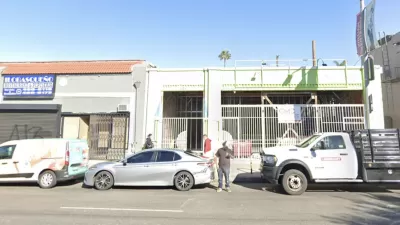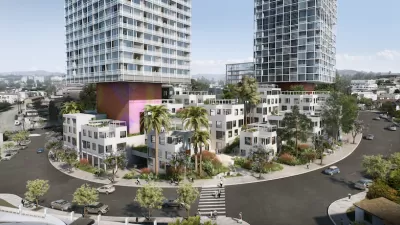Urban scholar Joel Kotkin says that gentrification has "failed" in Los Angeles. It's a curious notion, since gentrification is generally considered a bad thing. The reality is much more complex than Kotkin suggests.

For a guy who popularized the notion that the United States population will exceed 400 million by 2050, Joel Kotkin seems remarkably unconcerned about where everyone is going to live (see my review of his book The Next 100 Million).
For at least the past decade or so, Kotkin has reveled in being a contrarian, especially to remind the world that (quite rightly) not everyone is an urban hipster who wants to live in a loft. Kotkin believes that pretty much everyone should raise families in detached homes a million miles from his or her workplace and should be ashamed of themselves if they want to live in high-rise urban apartments.
In other words, Kotkin hates everything that's happening in Los Angeles these days. Kotkin's latest attack on progressive urbanism and oversimplification of urban issues, published recently in the Los Angeles Daily News, takes a particularly strange, contradictory turn.
Kotkin, who is nominally a right-winger (or at least libertarian), takes the opposite view. The headline of his piece reads, "Gentrification is Failing in Los Angeles," implying that gentrification is a good thing that has simply not come to fruition in Los Angeles. This is like saying wooden stakes aren't working for vampires.
Debates over gentrification in Los Angeles are, rightfully, intense and complex. Most of these debates are taking place on the left, where activists for social justice criticize high-end development for raising costs of living, pushing out low-income residents, and creating an air of exclusivity in a city that ought to be diverse and integrated. While there are disagreements about the causes of and solutions to gentrification, pretty much everyone agrees that gentrification is, in the abstract, A) bad; and B) not a goal but rather a consequence of development patterns and local economic conditions.
(Even the most craven, profit-driven developer knows that he or she should tout "community revitalization" rather than "gentrification.")
Kotkin cites neighborhoods like downtown Los Angeles and Hollywood, where development has been robust and, admittedly, focused on the upper end of the apartment market. These developments have been "driven by changes in zoning, public infrastructure including the rail system, laws promoting density and support for facilities such as the Convention Center as well as Staples Center. The city has lured large developers in some key areas, including Hollywood."
Kotkin's most dramatic claim is that the additional housing has not correlated with increases in jobs. He writes, "This investment has not created the kind of job growth we see in Chicago’s Loop, Manhattan or San Francisco"—as if development policies, rather than the phenomenal successes of the finance sectors, respectively, deserve credit for the economic success of New York and San Francisco (both of which are far more dense than L.A., which Kotkin bizarrely criticizes as "crowded"). He also notes, rightly, that Los Angeles County still has incredibly low average incomes. He punctuates this claim by noting, "Overall L.A. has lost jobs that pay more than $75,000 annually over the past decade….from 2000-12, median rents increased by 25 percent in L.A. County while income declined 9 percent." Given that it’s now 2019, choosing an interval of 2000-2012 is curious at best, even if the principle is more or less correct.
He writes as if gentrification was an economic development strategy gone wrong rather than the lamentable consequence of a constrained real estate market. This is rich coming from Mr. 450 Million.
It's certainly nice if development can lead to economic development, but the two aren't necessarily linked. The Los Angeles economy has been volcanic over the past decade. It doesn't need any help. It has been so robust that it has attracted and created people who want and can afford high-end apartments. If developers don't provide those apartments, those people will do one of two things: they’ll move to different cities, or they'll bid on existing apartments, thus inflating prices and cutting in on lower-income residents.
I'm not saying that all of these developments are perfect. But presumably they're good for the people who live in them, and they might even be good for the city as a whole, which happens to be suffering from a major housing shortage.
I'm also not saying that gentrification is "good." I would argue, though, that the version of gentrification that has arisen downtown is pretty benign. Most of those developments have been built on parking lots. They haven't displaced residents, and they haven’t destroyed existing communities. It's odd indeed that Kotkin criticizes the development of high-end residential housing there—he notes that "The L.A. area ranked as the No. 1 choice in North America in a survey of global commercial real estate investors"—since you’d think that "highest and best use" would be music to a libertarian's ears. If Kotkin wishes that those developments had been, say, reserved and subsidized for low-income residents, I would respect his social conscience. I'd also ask him where the money should have come from and why he has, as far as I know, never written a column about it.
Meanwhile, some of the city's most intense gentrification has taken place in neighborhoods like Venice and Silver Lake, where housing prices have gone stratospheric in the absence of new development. And gentrification has, because of rising rents, sparked "grassroots rebellion(s) in the Crenshaw district, Chinatown, south Los Angeles, and, most especially, east Los Angeles." None of these places is downtown, and very few of them have experienced "speculative" development—or any development at all. Therefore, none of them have anything to do with city policies.
Kotkin has yet again explained why Los Angeles has been doing everything wrong. And yet he offers no constructive suggestions. That's why he resorts to saying that Los Angeles has "failed" at implementing a bad thing—he can launch a double-criticism without actually sticking his neck out to suggest how Los Angeles can productively and equitably create jobs, ease traffic, and accommodate population growth. Instead, he writes vaguely, "(Mayor Eric Garcetti) needs to refocus urban policy away from real estate speculation and gentrification to one that serves the need of most middle- and working-class Angelenos." If Kotkin really cares about Los Angeles and is as smart as he thinks he is, surely he has some ideas about what that "policy" ought to be?
I guess his solution is that we should keep on gentrifying. We just need to do it better. Whatever that means.

Trump Administration Could Effectively End Housing Voucher Program
Federal officials are eyeing major cuts to the Section 8 program that helps millions of low-income households pay rent.

Planetizen Federal Action Tracker
A weekly monitor of how Trump’s orders and actions are impacting planners and planning in America.

Ken Jennings Launches Transit Web Series
The Jeopardy champ wants you to ride public transit.

California Invests Additional $5M in Electric School Buses
The state wants to electrify all of its school bus fleets by 2035.

Austin Launches $2M Homelessness Prevention Fund
A new grant program from the city’s Homeless Strategy Office will fund rental assistance and supportive services.

Alabama School Forestry Initiative Brings Trees to Schoolyards
Trees can improve physical and mental health for students and commnity members.
Urban Design for Planners 1: Software Tools
This six-course series explores essential urban design concepts using open source software and equips planners with the tools they need to participate fully in the urban design process.
Planning for Universal Design
Learn the tools for implementing Universal Design in planning regulations.
Ada County Highway District
Clanton & Associates, Inc.
Jessamine County Fiscal Court
Institute for Housing and Urban Development Studies (IHS)
City of Grandview
Harvard GSD Executive Education
Toledo-Lucas County Plan Commissions
Salt Lake City
NYU Wagner Graduate School of Public Service






























